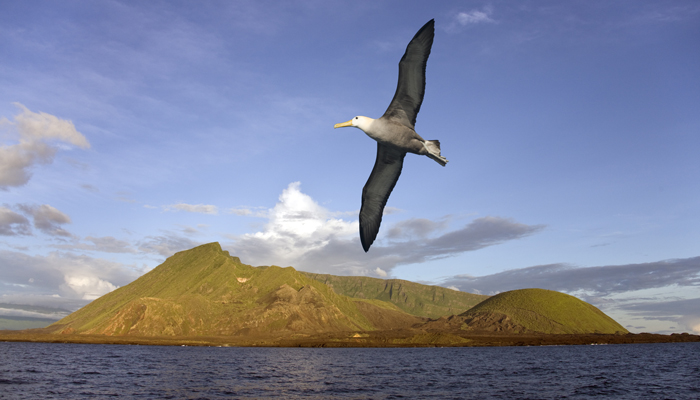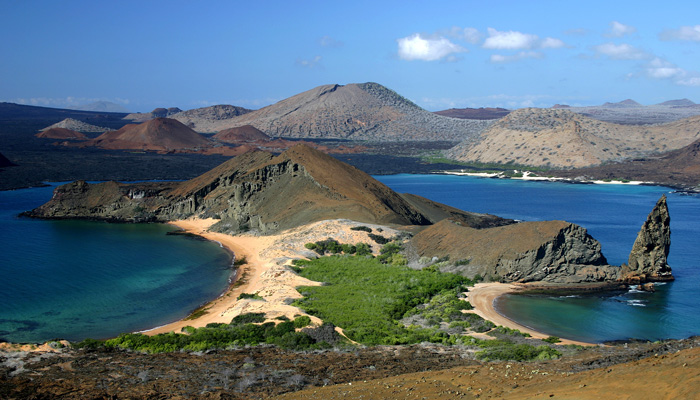Watch Wildlife in the Remote Galapagos Islands
The islands Darwin made his laboratory.
The Galapagos Islands. Home to some of the world's most fascinating animal species, from the venerable giant tortoise to the tiny Galapagos penguin. Cast out 1,000 km away from continental Ecuador, it's a spot so remote that evolution took a unique path for its inhabitants, resulting in species not found anywhere else on earth. The history of Galapagos makes for fascinating reading, but we think it has to be seen first hand to be believed.
Get Nose to Nose with Nature
If you're the sort of wildlife-lover who likes to get as close as possible to the action, one particularly pleasing quirk of the Galapagos Islands evolution story is their inhabitants' remarkable lack of fear for humans: because mankind did not set foot on the archipelago for so much of their species history, the animals simply haven't learned to be afraid of us. This means that you can approach most of the creatures you'll find here with ease, and the animals will simply go about their normal business. What better opportunity to study them in their native environment?
It goes without saying that wildlife is the main event on the Galapagos Islands, and the sheer diversity you'll encounter will blow your mind. But just being on this remote archipelago is an adventure in itself, and will appeal to anyone who has ever wondered what it would be like to step back in time and discover hidden corners of the world as the first explorers did.
Google Maps have put together a fascinating insider's guide to the Galapagos, complete with street maps created by scientists and researchers. Why not explore the islands at home before you visit for yourself? You can watch footage of this incredible project in the video below.
Tourism is heavily controlled in this unique natural paradise, and those who do visit can experience the world at its most untouched. It remains to be seen what the long-term impact of tourism in the region will be, but from a visitor's perspective the sooner you see it, the better. Further limiting of visitor numbers to Galapagos is always a possibility.
When to Visit Galapagos
Due to their position on the equator, the Galapagos Islands enjoy predictably mild to warm conditions all year round. There is a rainy season that tends to last from January to May or June, but this is also when the highest temperatures are observed, with the mercury often pushing above 30 degrees. Throughout the rest of the year the air is a little cooler, averaging 22 degrees - which will be more comfortable if you have hiking and other outdoor activities in mind.
The cost of an expedition (we find the word 'trip' just doesn't do it justice!) to Galapagos will also vary throughout the year, and there are two high tourist seasons when prices and visitor numbers rise steeply. These are Christmas and New Year, and the 'summer holiday' months of June to September. Limitations on total visitor numbers mean that cruises book up quickly at these times, and the cost of a visit can be expensive. Quieter times to visit are April-May, and October-November, so if you can get away at these times, you'll have the luxury of seeing the Galapagos Islands at their least crowded.
Exceptional Galapagos
Having made the substantial journey to the Galapagos Islands, you'll want to make the very best of your time, so we recommend planning a visit to certain attractions well in advance. The Charles Darwin Research Station is a must-visit, and this is where you can learn about and get to meet the famous giant tortoises that can live up to 200 years. Fortunately, many of the key attractions are in the great outdoors so don't require booking - but it's still worth scheduling them in. These include the stunning Tortuga Bay; a vast, white sand beach that's teeming with wildlife, including sunbathing iguanas and colourful crabs.
While most visitors to Galapagos make plenty of time to get acquainted with the islands' animal and bird population, many miss out on some of the most spectacular wonders of wildlife by staying on dry land. Galapagos also has breathtaking marine life, and the best way to see it is by snorkelling. If you're not an experienced diver you can learn all you need to get a glimpse of life under the sea at the Galapagos Dive Surf Club - take a look here at some of the incredible underwater experiences you could have.
The Galapagos Islands are a wonder of the natural world, offering a unique chance to experience wildlife at its most diverse and extraordinary. Remote enough to have largely escaped mankind's environmental footprint, the islands are unrivalled in their unspoiled splendour.
If you enjoyed this post like us on Facebook and follow us on Twitter or Google+.
Written by Abi Silvester, a London-based writer and editor with a passion for great food, fine wine, coffee and cats; always planning my next trip! Follow her on Twitter.
Add it to Your Bucket List
Latest posts
-
Why are people running into the New Year with empty suitcases?
December 22, 2025 10:35:53 am -
Why people set things on fire on the longest night of the year
December 18, 2025 10:51:50 am -
New year new holiday
December 16, 2025 01:13:12 pm -
Christmas traditions you literally won't believe
December 12, 2025 10:31:55 am -
Add these spooky destinations to your Halloween bucket list
October 23, 2025 04:00:31 pm



.png)


